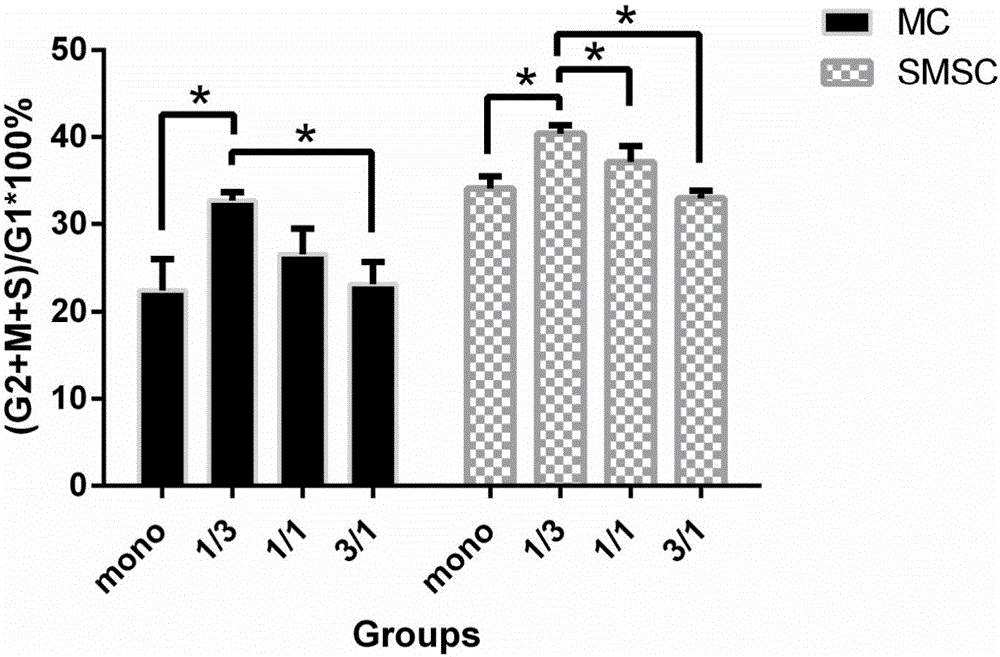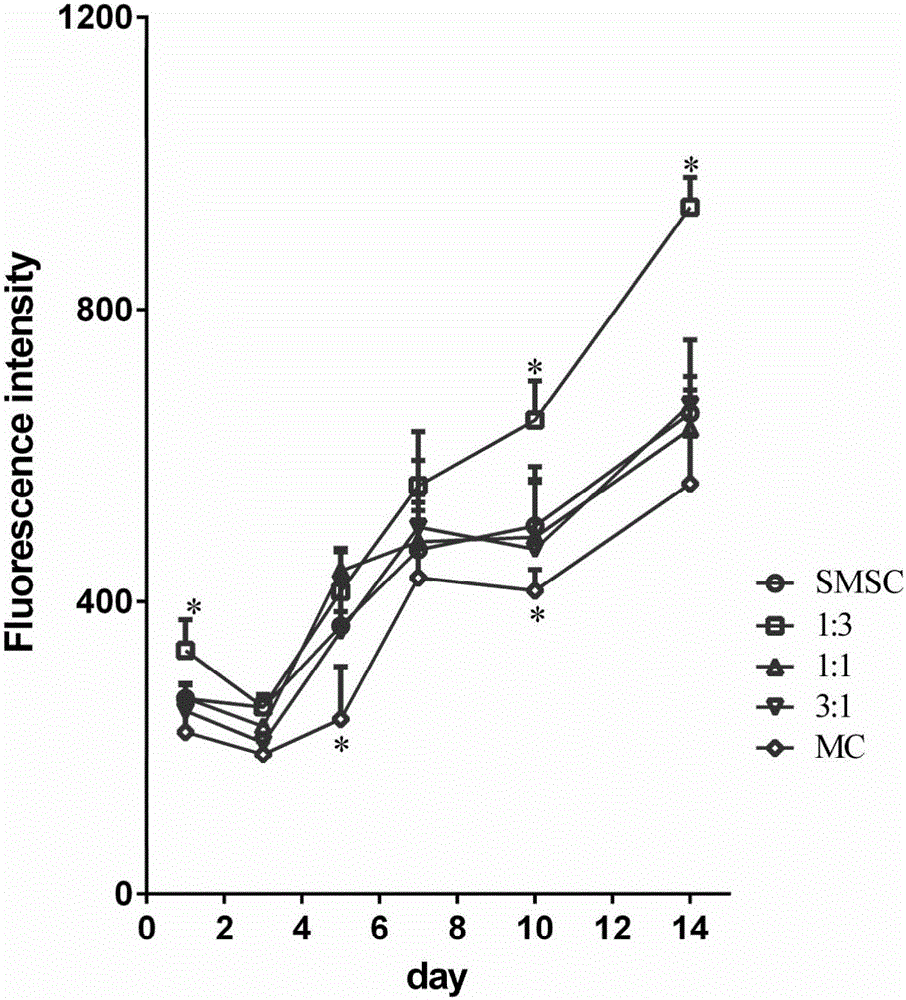Cell co-culture system for promoting cartilage differentiation and preparation method thereof
A co-cultivation system and co-cultivation technology, applied in the field of cell co-cultivation system and its preparation, can solve problems such as no optimization yet
- Summary
- Abstract
- Description
- Claims
- Application Information
AI Technical Summary
Problems solved by technology
Method used
Image
Examples
Embodiment 1
[0050] Obtain synovial mesenchymal stem cells from SPF grade 5-week-old male Sprague Dawley (SD) rats, wash the cells twice with PBS solution, and place them in a 25cm 2 Plate on the petri dish, add 3ml DMEM medium (containing 10% FBS, 1% penicillin-streptomycin);
[0051] In order to further isolate synovium-derived stem cells, the cells were passaged 3 times to remove non-adherent A-type macrophage-like cells, and the rest were synovium-derived mesenchymal stem cells (SMSCs), which grew to 80% confluence , subcultured, and cell flow cytometry confirmed that the cell purity was greater than 90%.
[0052] In this study, synovial mesenchymal stem cells were used in the experiments of P2-P5 generation cells.
[0053] Obtain meniscus cells from SPF grade 5-week-old male Sprague Dawley (SD) rats, wash the cells twice with PBS solution, and place them in a 25cm 2 Plate on the culture dish, add 3ml DMEM medium (containing 10% FBS, 1% penicillin-streptomycin); when the growth reach...
Embodiment 2
[0056] Cell proliferation after SMSCs and MCs are co-cultured in flow cytometry embodiment 1
[0057] Before starting co-culture, SMSCs were labeled with CFDASE fluorescent probe, and then resuspended three times in PBS to wash away the floating color. Unlabeled MCs and fluorescently labeled SMSCs were mixed evenly with low-sugar DMEM medium in different ratios, according to 30000 cells / cm 2 Density access Petri dish. Pure MCs and fluorescently labeled pure SMSCs at the same density served as controls for MCs and SMSCs in the co-culture group. On the 3rd day of co-cultivation, the cell ratio of the respective cell cycles of MCs and SMSCs in the co-culture system was detected by flow cytometry ( figure 1 ), where G2+M+S / G1 is used to calculate the cell proliferation rate ( figure 2 ). Such as figure 2 showed that the G2+M+S / G1 ratio of MCs in the co-culture group was increased (22.43±3.58%) compared with that of the pure MCs group; the G2+M+S / G1 ratio of SMSCs in the co-...
Embodiment 3
[0059] Cell proliferation after SMSCs and MCs co-culture in assay detection embodiment 1
[0060] SMSCs and MCs were co-cultured with Alamarblue assay at different time points. According to the kit operation steps, the cells were stained and incubated at 37°C for 3 hours, and then the fluorescence intensity was compared under a fluorescence spectrophotometer. Such as image 3 The results showed that the number of cells in the co-culture group with a ratio of 1:1 was higher than that of the other groups on the 10th day and 14th day. All co-culture groups had higher cell numbers than the MCs-only group on day 5 and 10, while the cell numbers in the 1:1 or 3:1 co-culture groups had no significant difference from the SMSCs-only group. And with the extension of culture time, the number of cells in all co-culture groups and SMSCs-only group was higher than that in MCs-only group.
PUM
| Property | Measurement | Unit |
|---|---|---|
| porosity | aaaaa | aaaaa |
| elastic modulus | aaaaa | aaaaa |
Abstract
Description
Claims
Application Information
 Login to View More
Login to View More - R&D
- Intellectual Property
- Life Sciences
- Materials
- Tech Scout
- Unparalleled Data Quality
- Higher Quality Content
- 60% Fewer Hallucinations
Browse by: Latest US Patents, China's latest patents, Technical Efficacy Thesaurus, Application Domain, Technology Topic, Popular Technical Reports.
© 2025 PatSnap. All rights reserved.Legal|Privacy policy|Modern Slavery Act Transparency Statement|Sitemap|About US| Contact US: help@patsnap.com



